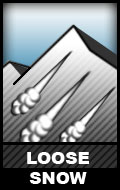Weekend Avalanche Outlook
Issued Friday, March 24, 2017 at 10:45am. This is a general backcountry (recreational) avalanche advisory for Chugach State Park with the Front Range and South Fork Eagle River areas as the core advisory zones.
*Generally safe avalanche conditions. Watch for unstable snow on isolated terrain features.*
The possibility for new snow returns next week. Beware that any significant accumulation, especially if accompanied by wind loading, will significantly increase avalanche danger. Avalanche conditions could rapidly change from generally safe to generally dangerous. Warming temperatures next week could also destabilize the snowpack.
Avalanche Problems:
Human triggered persistent slabs up to D2.5 in size are possible in isolated areas on steep (35*+), upper elevation (3000’+) terrain on multiple aspects. These persistent slabs are a low probability, but potentially high consequence hazard. The persistent slab problem is twofold this weekend.
The more likely human triggered persistent slab problem is old wind slab. We have generally found potentially problematic areas to be relatively obvious if you know what to look for: “fatter” pockets of less supported snow with a more bulbous appearance and hollow feel. Remember that while an avalanche may not be large enough to bury you, terrain traps (where the debris could pile up especially deep or you could take a traumatic fall) can seriously compound the consequences.
The second, less likely, persistent slab problem is related to the widespread basal weak layer and lingering pockets of intact buried surface hoar. Problem areas may exist on steep, high alpine terrain where the human “stress bulb” can penetrate deeper into the snowpack and initiate fracture. Such “sweet spots” are most likely where there are thinly covered or sparsely protruding rocks (harboring facets closer to the surface) and thin areas of the snowpack (where the persistent weak layer is closer to the surface), especially at convexities where the snowpack lacks compressive support.
Any lingering persistent slabs will behave unpredictably, with hard slab characteristics, potentially releasing above and around a human trigger (making escape difficult).
Sluffing is possible where there is soft snow on steep (35*+) terrain. It’s generally expected to be low volume but be alert, practice effective sluff management, and keep the consequences of a fall or loss of control in mind.
There is also the potential for wet loose avalanches this weekend on steep solar aspects (primarily south to west), especially initiating from snow dropping from rocks that warm in the sun. It is expected to be rather limited due to relatively cold spring temperatures, but be conscious of the temperature and solar effect on the snow. Also, watch for rockfall associated with the sun warming snowy rock in steep, channeled terrain.
As always, don’t approach a snowy ridge line to look down slope unless you’re sure it’s not corniced. Cornice falls are inherently dangerous, and they can also trigger an avalanche as they “bomb” the slope they fall onto. Give corniced ridges a wide berth; they have the potential to break further back than may be expected.
Mountain Weather:
Expect generally sunny skies with light north to east wind and alpine temperatures from the lower 20s to teens (decreasing temps with increasing elevation – no inversion).
Weekday Avalanche Outlook:
The current snow surface is highly variable. It generally consists, especially in avalanche starting zones, of firm to very firm snow. In most areas a hard wind slab is capped with a layer of heavily faceted snow ranging from several cm to less than a cm thick. This potential (hard wind slab) bed surface and (faceted) weak layer recipe could be complete with slab, if we receive snow next week.
In many alpine areas, especially steep and less sheltered northerly terrain, we have found a smooth pencil hard wind slab with a thin (~1cm) layer of heavily faceted snow on top. These areas are expected to be especially reactive when loaded with new snow, and this effect could be greatly exacerbated by wind loading – especially if flow changes to a more southerly tilt, wind loading suspect northerly terrain.
Additionally, any new snow will fall on varied hard and slick surfaces: boilerplate, sun crusts, radiation recrystallization crust, and rime ice. Such surfaces, even without weak layer, could create a reactive weak interface.
__________
Many avalanche accidents that have happened in Anchorage’s backyard of Chugach State Park could have been prevented by basic avalanche awareness. If you don’t have this level of awareness, here are some online resources to help you start the learning process. There are also numerous options for getting a real avalanche education locally.
__________
*click avalanche problem icons and hyperlinks for further info


